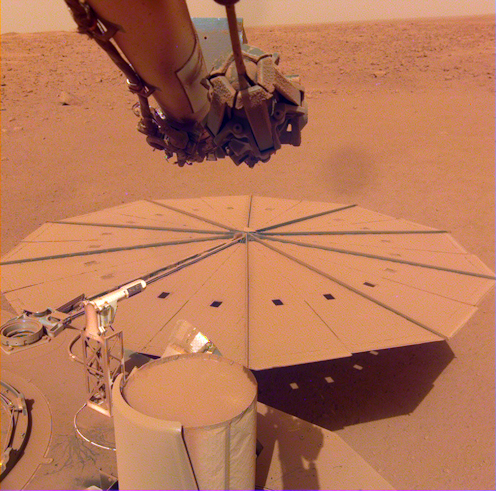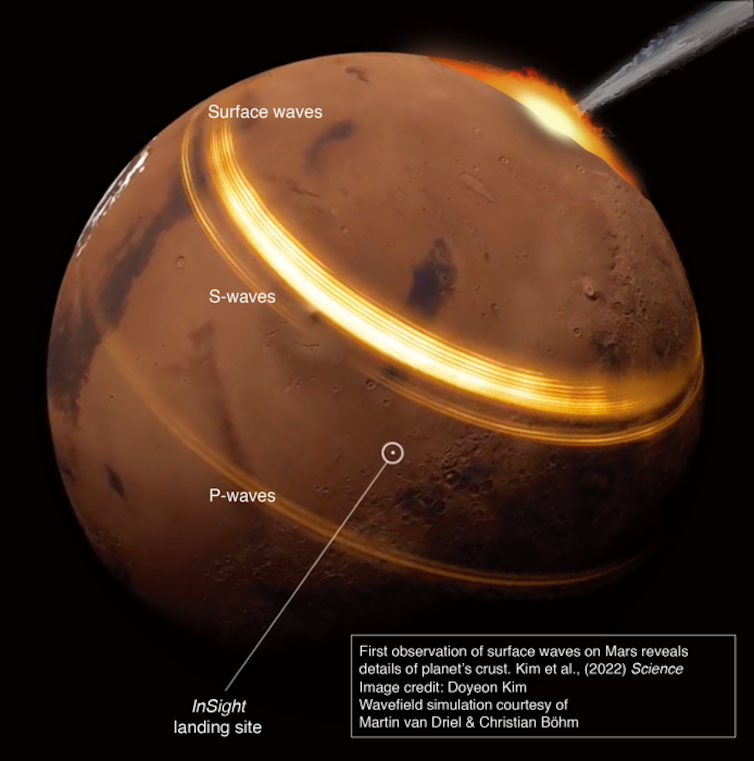
Most of the worlds of our Solar System are pockmarked with impact craters. These bear testament to the violence of the early days of the Sun, when asteroids, comets and entire planets routinely collided with and annihilated each other.
Our own Moon was most likely formed by one of these collisions, and is itself home to the largest impact feature in the Solar System – the South Pole/Aitken Basin, some 2,500km across. Mars’ vast, flat northern deserts may too have formed during a gigantic collision some 4 billion years ago.
Today’s Solar System is a much more peaceful place. But impacts from meteorites are still one of the dominant processes shaping planetary landscapes on most worlds other than the Earth. Now our new study of the largest recent impact craters on Mars, published in Science, sheds new light on the red planet’s interior.
Examining impact craters can teach us a lot – from understanding the composition and size of the asteroids or comets which created them, through to unearthing the properties of planetary surfaces and interiors. The interiors of craters can in fact be used to study otherwise inaccessible underground geology. The degree of cratering on a surface can also be used to estimate its age: the older it is, the more craters (usually).
Late last year, Nasa’s InSight spacecraft, which is on the surface of Mars “listening” to seismic waves in the planet’s interior, detected two enormous “marsquakes” around 90 days apart – among the largest we have seen so far during our research.
These marsquakes were rather different to previous ones recorded by InSight. For example, they seemed to be what we call “surface waves” – that is, seismic waves propagating in the outermost layers of the martian crust (its surface layer).
These sorts of waves are rare. They are also particularly exciting because they allow us to “map” the structure of Mars’ highly unusual crust, which is much flatter in the northern hemisphere and thicker and more mountainous in the southern.
Martian detective work
We could tell the marsquakes probably had a shallow origin – potentially produced by an enormous impact event rather than originating from processes deeper within the planet’s interior. By analysing the seismic waves that InSight recorded, we were also able to work out the marsquakes’ approximate epicentre, or point of origin. Because these two quakes were so unusual, we requested follow-up observations from the Mars Reconnaissance Orbiter spacecraft which orbits the planet.
The results were quite remarkable. The epicentres of both marsquakes were found to correlate with the positions of enormous black smudges on the planet’s surface – the blast zones of new impact craters. Looking back at older, low resolution images allowed the imaging team to pin down the exact dates for the formation of the craters, which coincided exactly with when the marsquakes were detected by InSight.

The craters themselves were enormous – around 130m and 150m in diameter respectively. The “blast zones”, created by the shockwaves from the meteors entering the atmosphere and impacting the surface, extended out for dozens of kilometres. These were by far the biggest fresh craters we had ever seen form anywhere in the Solar System.
The larger of the two craters was only around thirty degrees north of Mars’ equator – by martian standards, a semi-tropical latitude. At the bottom of the crater were chunks of what was identified as ice (from water), excavated by the impacting body as it broke through into an underground frozen layer. This was the closest to the equator that we’d ever seen ice, and means that there is likely more water on Mars (albeit frozen) than previously thought. This is particularly important if humans are to one day settle there.
As it turned out, the surface waves from one of the events were so strong that they had actually been recorded by InSight after going both ways around the planet – a first for seismology.
By analysing the surface waves, we were also able to create an image of the structure of the crust. Initial results suggested that the differences between the northern and the southern hemisphere might be more superficial than previously believed. Specifically, it looked like some of the differences in the crust were confined to the area very near the surface rather than extending deeper down. Why the northern and southern hemispheres look so different, despite being very similar at even shallow depths, remains a bit of a mystery.
We also don’t know why these two craters formed so close to each other in time – much closer together than random statistics would suggest is likely. One theory that we explored was whether an asteroid may have broken up in orbit around Mars and the fragments slowly re-entered the atmosphere over a period of several months, creating different craters. But the lack of any other similarly sized craters or direct evidence for this makes it challenging to prove.
Sadly, the detection of these impact events is likely to have been one of the last results of the InSight mission. The spacecraft’s solar panels are now so dusty that it is becoming impossible to keep the batteries charged enough to remain operational. Although we will keep listening for as long as we can, it may be only after the next set of seismometers are sent to Mars that we can explore some of these unanswered questions about impact events on the red planet.
The author received some funding for the work preliminary to this effort from the UK Space Agency.
This article was originally published on The Conversation. Read the original article.







